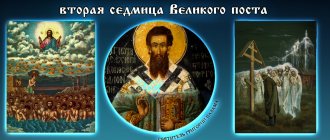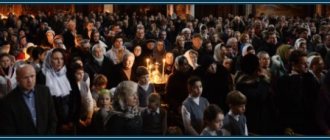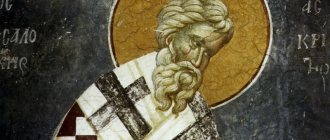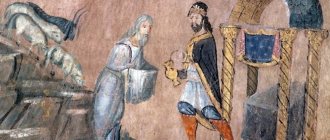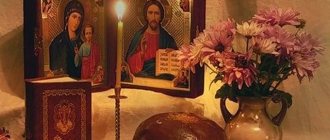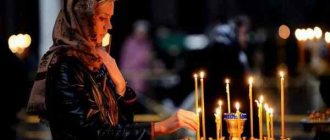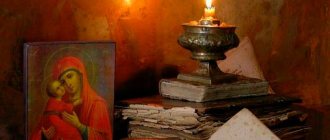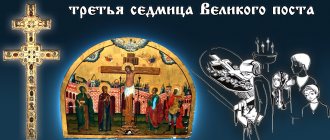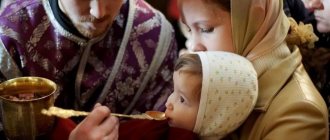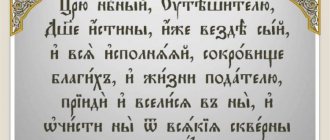First week of Lent
This week's features:
During the first four days of Great Lent, the Great Penitential Canon of St. Andrew of Crete is read at the evening service. This reading sets us up and gradually introduces us to Lent, as a time of special struggle and repentance.
Starting this week and throughout Great Lent, from Sunday evening to Friday, the prayer of St. Ephraim the Syrian is read:
Lord and Master of my life, do not give me the Spirit of idleness, despondency, covetousness and idle talk. Grant the spirit of chastity, humility, patience and love to me, Your servant. Hey, Lord, King! Grant me to see my sins, and not to condemn my brother, for blessed art thou unto the ages of ages. Amen.
It seems to be very short, but it contains a very important idea about the purpose of the great and small feats that we perform during Lent and beyond.
First of all, this is our liberation from illnesses, that is, a kind of addiction, whatever, which has taken over our life and freedom of choice. They guide us and hinder our movement on the path to God.
On Saturday of the first week (week) the memory of the Holy Great Martyr Theodore Tiron is celebrated.
Saint Theodore delivered Christians from persecution by the Roman emperor Julian the Apostate, who lived in the 3rd century.
Julian was a pagan and, wishing to outrage Christians, ordered the mayor of Constantinople to sprinkle all food supplies in the markets with blood sacrificed to idols in the first week (week) of Lent. Saint Theodore, appearing in a dream to Archbishop Eudoxius, ordered to announce to all Christians that no one should buy anything in the markets, but instead let them eat boiled wheat with honey (kolivo, kutia). By doing this, the Christians were not disgraced by the emperor.
And it was in memory of this miraculous appearance of Saint Theodore Tyrone that the Church established a celebration on the first Saturday of Great Lent.
On the Sunday of the first week (week), the church celebrates the Triumph of Orthodoxy .
In the middle of the 9th century, the period of iconoclasm, which lasted a century and a half, ended in Byzantium. The dispute over whether it is possible to depict Christ, the Mother of God, and saints and pray in front of these images resulted in severe persecution and murder of icon worshipers.
After the church council of 843, which condemned the iconoclasts and restored icon veneration in the empire, Queen Theodora proposed organizing a church celebration, which fell on the first Sunday of Lent.
In memory of this event, every year on the first Sunday of Great Lent, the Orthodox Church solemnly celebrates the restoration of icon veneration, called the “Triumph of Orthodoxy.”
By the 14th century, a special rite of the Triumph of Orthodoxy had developed, which was supplemented by texts containing Orthodox dogmas. The text of the service proclaims the triumph of the Church over all existing heresies, and affirms the decrees of the seven Ecumenical Councils.
What can you eat in the first week of Lent?
On the first day of Lent you are supposed to abstain from food.
On other days you can eat vegetables, fruits, cereals of various kinds, but you are not allowed to eat food of animal origin (milk, eggs, meat and fish), also from Monday to Friday, unless there is a holiday on these days, you do not eat vegetable oil. However, it should be remembered that all these rules are spelled out in the monastery charter. Lay people (i.e., non-monastics), as a rule, fast more softly - for example, they limit themselves only to excluding food of animal origin and fish (or fish on weekdays).
Great Compline with the Canon of St. Andrew of Crete
On the weekdays of Great Lent and on the days of Lesser Lent, when the service with Hallelujah is celebrated, as well as on those days of the year when Vespers is served in the afternoon (for example, Christmas and Epiphany Eve), the Charter prescribes the celebration of Great Compline. In the first four days of Great Lent, Great Compline is celebrated with the reading of the canon of St. Andrew of Crete, and it is divided into four parts.
The rite of Great Compline consists mainly of psalms and is divided into three parts. The first part includes six psalms and the vibrant song God is with us from the book of the prophet Isaiah. The second part also includes psalms and a prayer from King Manasseh taken from 2 Chronicles of the Old Testament. The third part includes psalms and doxology, after which the Theotokos canon and a special chant “Lord of hosts, be with us…” with verses of the 150th psalm are sung. The charter specifies to sing them “slowly and inertly”
, i.e. very loud and slow.
In the first four days of Great Lent, the canon of St. Andrew of Crete is appointed at Great Compline, but not in the final part, but in the very first. The service begins like this: “Blessed be God...”, the usual beginning and the 69th Psalm, which is in the third part of Great Compline, but during these four days it is moved to the beginning, and then it is no longer repeated in its usual place. After the 69th Psalm, the reading of the canon of St. Petersburg immediately follows. Andrey Kritsky.
The Great Canon is a miracle of all church hymnography; these are texts of amazing power and beauty. It begins with a text addressed to Christ:
“Where will I begin to cry about my accursed life and deeds? Shall I make a beginning, O Christ, for this present mourning?”
where should I start to repent, because it is so difficult. Then follows the famous troparion:
“Go, damned soul, with your flesh. Confess to the Creator of all..."
Amazing words, here is both Christian anthropology and asceticism: the flesh must also participate in repentance, as an integral part of human nature.
In its content, the Great Canon represents a conversation between a penitent and his own soul, and from the very first words an appeal to his soul follows:
“Come, accursed soul, with your flesh, confess to the Creator of all, and remain the rest of your former speechlessness, and bring tears to God in repentance.”
This conversation with the soul, its constant persuasion, calls to repent, reach its apogee in the kontakion, which is sung after the 6th song:
“My soul, my soul, arise, what are you writing off? The end is approaching, and if you are embarrassed, rise up, so that Christ God, who is everywhere and fulfills everything, will have mercy on you.”
Among the main features of the Great Canon we must include the very wide use of images and plots from Holy Scripture, both the Old and New Testaments. In these examples, the soul is constantly exhorted - remember this righteous man, he pleased God so much, remember this righteous man, he pleased him so much - you did nothing of the kind.
In the very first troparia Adam and Eve are remembered, and a great many biblical characters are remembered: Moses, Aaron, Abraham, Joseph. Some are spoken of in a positive sense, others in a negative sense, some need to be imitated, some not.
“The charioteer Elijah, with the chariot of virtues, entered as if into Heaven, sometimes carried higher than earthly things. For this reason, my soul, think of the sunrise.”
think, my soul, about the ascension of the Old Testament righteous.
“Thou hast imitated Gehazi, accursed one, always with a bad mind, the soul, whose love of money put aside until old age, flee the fire of Gehenna, having retreated from thy evil ones.”
at least in old age, reject Gehazi’s love of money, soul, and abandon your atrocities, avoid the fire of Gehenna. As you can see, the texts are quite difficult, so it is necessary to prepare in advance for the perception of the Great Canon.
In the final song of the first day, after all the memories, troparia of amazing power follow:
“The law is weak, the gospel celebrates, but the scriptures are all careless in you, the prophets are weak, and all the righteous word: your scabs, about your soul, having multiplied, I am not a physician who heals you.”
there is nothing to remember from the Old Testament, everything is useless. I will give you examples from the New Testament, maybe then you will repent:
“I bring new instructions from the Scriptures, leading you, the soul, to tenderness: be jealous of the righteous, turn away from sinners, and propitiate Christ with prayers and pampering and purity and persecution.”
The worst sinners have repented and will come to the Kingdom of Heaven before you:
“Christ became man, calling the thieves and harlots to repentance: soul, repent, the door of the Kingdom has already been opened, and the Pharisees and the publican and the adulterer who repents are anticipating it.”
The Great Canon, moving us to repentance by all means, in the last troparia seems to reveal to us its “methodology”: as I talked with you, my soul, I reminded you of the righteous men of the Old Testament, and gave you New Testament images as an example, and all in vain:
“You were not jealous of them, either in soul, neither in deeds, nor in life: but woe to you, if you are ever judged.”
Woe to you when you appear in court!
At the end of Great Compline there is a rite of forgiveness, similar to that which was performed on the week of evening. Indicated after the last prayers of Great Compline:
“The primate bows to the ground, saying to the brethren: Bless the holy fathers, forgive me the sinner who has sinned in word, deed and with all my feelings.” Brethren: “God will forgive you, Holy Father.”
Thus, the service of the first week introduces us to Great Lent, educates, inspires, exhorts, directing us to the Lenten feat.
Second week of Lent
This week's features:
Saturday of the second week (week) is the day of special remembrance of the dead, parent's Saturday.
These days, together with the Church, we can pray for our deceased relatives and friends. Usually certain prayers for the dead are performed collectively after the Liturgy. But, since during Lent Liturgies are held only on Saturdays and Sundays, then on other days we and our loved ones are deprived of this. Therefore, the Church has set aside several days when we can fervently pray for those who are not with us.
Why is it important to remember the dead? Because they no longer have the opportunity, as during life, to confess their sins and receive forgiveness for them, but we can help them with our love and prayer.
On Sunday of the second week (week), the church remembers St. Gregory Palamas .
Saint Gregory Palamas wrote many works, but one of his greatest works, the most important, is the so-called “Tomos of Faith”. And in it Saint Gregory Palamas says that the image of God is imprinted in us. He is always with us, he is in us - this light. We have reliable support within us. And realizing this, it is easier to move on.
What can you eat during the second week of Lent?
You can eat vegetables, fruits, cereals of various kinds, but eating food of animal origin (milk, eggs, meat and fish) is not allowed, and from Monday to Friday, unless there is a holiday on these days, vegetable oil is not consumed. On the remaining Saturdays and Sundays of Lent and on the days of some especially revered saints, for example, the Forty Martyrs of Sebaste - March 22, and St. Gregory the Dvoeslov - March 25, vegetable oil is allowed. However, it should be remembered that all these rules are spelled out in the monastery charter. Lay people (i.e., non-monastics), as a rule, fast more softly - for example, they limit themselves only to excluding food of animal origin and fish (or fish on weekdays).
Everyone knows that Lent begins on Monday. Why?
After all, according to the biblical and church counting of days, this is already the second (!) day of the week as a seven-day calendar cycle. Yes, simply because the period of repentance and crying about one’s sins cannot begin with the festive “Little Easter,” as every Sunday is called, celebrated with a solemn Liturgy and accompanying joyful singing! This leads to understandable confusion for those who want to understand the structural features of our Lenten cycle. Indeed, the past Cheese Fat Week (or Forgiveness Sunday, March 13, 2016) is already the fourth (!) “week” of the preparatory period for fasting. But this period itself consists of three weeks in the usual sense (more precisely, three weeks, the 21st day, plus one more, the 22nd day, Forgiveness Sunday!).
To resolve this apparent contradiction, let us remember that in church calendar usage the word week means only one day - Sunday (the Slavic word week comes from the phrase not delati - that is, “not to work”
, but dedicate this sacred day to God).
Therefore, Lent begins not on a holiday Sunday, but on a weekday Monday (its very name means week by week, that is, after a week!). Accordingly, the first Lenten week (= Sunday) begins only on the seventh day: this first Sunday within the Lenten period is dedicated to the Triumph of Orthodoxy. It is quite clear that Lent also ends on a “weekday”
day (in quotes, because we are talking about the formal place of this day within the seven-day weekly cycle, and not about its Christian content!).
This is the “theology of time”
: the Lenten penitential period begins on Monday, and the festive Easter cycle begins with the main Resurrection (Easter) of the year! And this Day itself is the first Easter week. Next Sunday is already the second Easter week, etc.
Third week of Lent
This week's features:
Saturday of the third week (week) is the day of special remembrance of the dead, parent's Saturday.
Each of us must understand the importance of this prayerful memory. That we act here as a kind of support. We pray for peace of mind, forgiveness of sins, and if we really do this from the bottom of our hearts, then we give incredible support to our loved ones.
Week of the Worship of the Cross
On Sunday of the third week (week) of Great Lent, at the All-Night Vigil, the Life-Giving Cross of the Lord is brought into the center of the church, which is worshiped by believers throughout the next week until Friday.
When bowing, the following is sung:
We worship Your Cross, Master, and we glorify Your Holy Resurrection.
Previously, Lent was closely connected not only with Easter, but also with the Sacrament of Baptism.
It was believed that the time of Lent for people called catechumens (that is, ready to receive holy Baptism) is a special preparatory period, to which they approach with special attention and trepidation.
For us, this is primarily the memory of the suffering on the cross of Christ our Savior, that He went through this for our sake. The cross is our support, our strengthening in faith.
Here is what Metropolitan Anthony of Sourozh says about this in one of his sermons:
“The cross tells us that we are so loved by God that the Lord is ready to die, if only we would live, if only we would come to life from the death of sin. Being so loved, can’t we really rejoice and rejoice in these days of Lent, spiritual spring? We can. The cross is revealed to us now as hope, as confidence in God’s love and in His victory, as confidence that we are so loved, that everything is possible, that we can hope for everything.”
What can you eat in the third week of Lent?
You can eat vegetables, fruits, cereals of various kinds, but eating food of animal origin (milk, eggs, meat and fish) is not allowed, and from Monday to Friday, unless there is a holiday on these days, vegetable oil is not consumed. However, it should be remembered that all these rules are spelled out in the monastery charter. Lay people (i.e., non-monastics), as a rule, fast more softly - for example, they limit themselves only to excluding food of animal origin and fish (or fish on weekdays).
Sunday passions
On the days of Holy Pentecost, another exceptional divine service is celebrated - Passion. It is served on four Sundays, from the second to the fifth, during the days of fasting. Passion came to us from the same place where the black vestments of the priesthood came from - from the West. From Latin “passion” is translated as “suffering” .
This service is not in the church charter, so its content may vary in different churches. The following of the passion has reached us in the form in which it was compiled in the middle of the 17th century by Metropolitan Peter (Mogila). In fact, this service is the evening service of Lent on Monday. At the same time, an akathist to the Cross or Passion of the Lord is served.
The obligatory part is reading a passage from one of the Gospels about the Passion of Christ. Hence the number of passions in a year - according to the number of four evangelists. After the service, a sermon must be preached, for which the clergy carefully prepares.
Fourth week of Lent
This week's features:
Saturday of the fourth week (week) is the day of special remembrance of the dead, parental Saturday. Specially designated time for prayer for the souls of the dead It is important to preserve and honor the memory. At this time, we must try to put aside our earthly vain worries and devote our time to our deceased loved ones.
On the Sunday of the fourth week (week) the memory of St. John the Climacus .
St. John is a great ascetic who, with his life and his feat, showed us an example of the highest meekness, repentance and humility. He led a hermit's life; the monk spent 40 years in the feat of silence and prayer.
St. John is the author of the spiritual creation “The Ladder.” These are instructions and guidance for spiritual life. In the book, the path of a Christian is presented as a leisurely ascent up a ladder.
This is what the monk writes about repentance:
“Repentance is our return to God, the renewal of our baptism; this is a feat to renew our union with God, our vow to change our lives. This is the time when we can learn humility, that is, peace: peace with God, peace with ourselves, peace with all creation. Repentance is born from hope and a decisive rejection of despair. And the repentant is the one who deserves condemnation, but leaves the court without shame and disgrace, because repentance is our reconciliation with God.”
What can you eat during the fourth week of Lent?
You can eat vegetables, fruits, cereals of various kinds, but eating food of animal origin (milk, eggs, meat and fish) is not allowed, and from Monday to Friday, unless there is a holiday on these days, vegetable oil is not consumed. On April 7, in honor of the celebration of the Annunciation of the Blessed Virgin Mary, fish is allowed. However, it should be remembered that all these rules are spelled out in the monastery charter. Lay people (i.e., non-monastics), as a rule, fast more softly - for example, they limit themselves only to excluding food of animal origin and fish (or fish on weekdays).
Throughout Great Lent, the repentant prayer of Ephraim the Syrian is read.
- What we ask for in a prayer of repentance: The prayer of Ephraim the Syrian is a prayer of repentance; it lists all the main sins for which we need to repent.
- Spirit of Idleness: The root of all sins is idleness, time wasted on self. Without engaging in our development and the gifts of our soul.
- Dejection: modern society, being in a spirit of idleness, then falls into despondency and is unable to do any good or pray to God.
- Lust for power: this is the love of power, to have power in a team or in a family. This sin is facilitated by the sins of despondency and the spirit of idleness.
- Idle talk: Swear words, empty talk leading to condemnation and insult.
- Chastity: spiritual control over one's emotions and over one's body. Moral purity in deeds, words and thoughts.
- Humility: The fruit of chastity, a person stops considering himself better than others. The soul is cleansed of pride and selfishness.
- Patience: This is when an emotional person becomes intolerant and is quick to judge and condemns his neighbor and is quick to judge.
- Spirit of Love: Love is the most important gift and the main goal of our spiritual works. God is love!
Fifth week of Lent
This week's features:
Saturday of the fifth week (week) is the day of Akathist or Praise of the Blessed Virgin Mary .
There are several options for establishing this celebration.
Through prayers to the Most Holy Theotokos, Constantinople was saved from the invasion of Arabs and Persians in the 7th century.
And at the same time, this celebration is closely connected with the Annunciation of the Blessed Virgin Mary, since before the holiday was established on April 7, it was moved to the 5th Saturday of Great Lent.
On Wednesday evening (Thursday morning) at the service the so-called “Standing of Mary” , during the service the Great Penitential Canon of St. Andrew of Crete is reread in full, and the life of the Venerable Mary of Egypt is also read as an example of deep repentance and correction of one’s own life.
As for the full reading of the canon, it was assigned to this day not by chance, but in memory of the earthquake that occurred approximately between the 4th and 5th centuries in the East. Over time, the tragedy was forgotten, but the tradition of reading the Great Penitential Canon remained.
On Sunday of the fourth week (week) the church honors the memory of St. Mary of Egypt.
The Venerable Mary is also known for her feat of ascetic life. She showed an example of intense struggle and repentance, which are capable of raising a person even from complete spiritual collapse, the abyss.
What can you eat during the fifth week of Lent?
You can eat vegetables, fruits, cereals of various kinds, but eating food of animal origin (milk, eggs, meat and fish) is not allowed, and from Monday to Friday, unless there is a holiday on these days, vegetable oil is not consumed. However, it should be remembered that all these rules are spelled out in the monastery charter. Lay people (i.e., non-monastics), as a rule, fast more softly - for example, they limit themselves only to excluding food of animal origin and fish (or fish on weekdays).
Reading the canon of Andrei Kritsky
Is it obligatory for Orthodox Christians to be present during the reading of this canon? Are there any canonical rules?
The canonical tradition of the Orthodox Church speaks of the need to be present at the Liturgy. There are no such instructions regarding the canon of Andrew of Crete. But it should be understood that it is not the principle of obligation that is important (as they say, “a slave is not a pilgrim”
, no one will force anyone), but the desire and decision to be in the Church during the service.
Of course, there are a number of factors that can influence: work, business trips, illness, the health of others, urgent matters, etc. It is precisely the desire
to be involved in the liturgical life of the Church
that is tested in such a situation
, when, on the one hand, there is everything these are urgent and weighty reasons, on the other hand, the desire to attend all services at least for the first week.
The following comparison can be made: a person sets aside time to play sports or attend courses, but when it comes to worship, there are a thousand arguments why not to go to church:
your legs hurt, your back hurts, you’re lame, you’re blind, you have a long way to go, you don’t understand anything, etc. These are excuses.
People, tired of work, find time to go to, say, foreign language courses at the end of the working day. Where, too, not everything is clear, but nevertheless they are ready to spend time and effort to understand the language, but for some reason in a situation where it is not clear what they read in the temple, they do not waste time and effort to understand, but accept radical Solution: I won’t go at all. This behavior is illogical. If a person is interested in understanding what is read at a service, he will find an opportunity to understand and understand. In general, as they say, “those who want, look for opportunities, and those who don’t want, look for reasons
.
There really are a lot of worries in life, people have grown into the bustle of worldly affairs, and Lent is precisely the period when at least a small part of one’s time needs to be allocated and devoted to God. Grigory Dvoeslov has an interesting idea on this matter, who considers Lent as a tithe of the year
which must be given to God.
Indeed, if you do not take into account Sundays, when fasting is relaxed, and Holy Week (which in the charter is considered separately from the Holy Pentecost), then you get 36 days
, i.e. practically a tithe of the year.
The Great Canon is another of the few possibilities for kneeling prayer. There are not many services where the entire temple bows to the ground. Tell us about this feature.
Kneeling
in the Orthodox Church it is associated with deep contrition of the heart, with
repentance
.
For example, bowing to the ground on days of joy is incorrect and is not prescribed by the Charter. For example, on Easter days bows are canceled
.
But during Great Lent, during the period of intense feat, reminders of repentance, you need to act in accordance with your condition. Of course, kneeling introduces us to an atmosphere of repentance. Therefore, whenever possible, you need to bow to the ground: during prayer, St. Ephraim the Syrian, after each troparion of the Great Canon of St. Andrey Kritsky. At one time this was a widespread practice, but then, due to various circumstances, it was not present in all churches. Nevertheless, now, in the first week of Great Lent, parishioners of the Kiev-Pechersk Lavra and many parish churches, young and old, bow to the ground for each troparion of the Great Canon of St. Andrey. from a conversation with Archimandrite Sylvester (Stoichev) about Lenten services (based on materials from praflife.org)
In almost all churches, the Great Canon is usually read at 18:00, so that people have time to go to church after work. But there are situations when there is no way to be in church all evenings. Then it will be very useful and good to read the canon at home. Below you can download the texts of the canon both for each day of the first week and the full text of the canon.
Canon of Andrew of Crete on Monday of the first week of Great Lent
Canon of Andrew of Crete on Tuesday of the first week of Great Lent
Canon of Andrew of Crete on Wednesday of the first week of Great Lent
Canon of Andrew of Crete on Thursday of the first week of Great Lent
Full text of the canon of Andrew of Crete in Church Slavonic ( c/w. font
)
Full text of the canon of Andrew of Crete in Church Slavonic ( civil script with parallel translation
)
Passion Week
This week's features:
Week Vai (vaya translated from Greek - branch) - the name refers us to the main event of this week - the Entry of the Lord into Jerusalem, this holiday is also called Flower Week or Palm Sunday . On this day, according to tradition, it is pleasant to consecrate palm branches, which are replaced by willow branches.
At the services of this week, starting from Monday, stichera and troparions dedicated to this holiday are heard.
Saturday of the sixth week (week) is called Lazarus , since on this day the Orthodox Church remembers the miracle of Christ’s resurrection of the righteous Lazarus.
Remembering this event is very important and significant for all people. Christ raised the righteous Lazarus in order to testify to everyone about the possibility of a general resurrection on the day of the Last Judgment. And what is impossible for man to create is possible for God.
On the eve of Friday, Great Compline is celebrated. On the day of Lazarus Saturday, the Liturgy of St. John Chrysostom is served.
These festivals - Lazarus Saturday and the Entry of the Lord into Jerusalem - bring us to a special period - Holy Week, which is no longer part of Great Lent, but brings us very close to the day of the Resurrection of Christ.
What can you eat during the fifth week of Lent?
You can eat vegetables, fruits, cereals of various kinds, but eating food of animal origin is not allowed, and from Monday to Friday, unless there is a holiday on these days, vegetable oil is not consumed. However, it should be remembered that all these rules are spelled out in the monastery charter. Lay people (i.e., non-monastics), as a rule, fast more softly - for example, they limit themselves only to excluding food of animal origin and fish (or fish on weekdays). On April 9, in honor of the Feast of the Entry of the Lord into Jerusalem, fish is allowed at the meal. Caviar is allowed on Lazarus Saturday.
Seventh week of Lent
Holy Week (week) is a special period in the life of the Church and every believer, which brings us closer to the Great Day of Christ’s Resurrection.
This week's features:
This week is dedicated to remembering the last days of the earthly life of Jesus Christ. All services of Holy Week symbolize the spiritual procession along the Way of the Cross with Christ.
This week is also unique in its liturgical structure. Every day is different.
At Divine Services a number of chants are sung that can only be heard during this period.
It is especially customary to highlight three days during Holy Week - Maundy Thursday, Good Friday and Holy Saturday. This is kind of the culmination of this week.
Maundy Thursday (Thursday):
In the morning, the Liturgy of St. Basil the Great is served, during which all Orthodox Christians receive communion, remembering the Last Supper, at which the first Communion took place. In the evening, Good Friday Matins is celebrated - a long service at which the 12 Gospels about the suffering of Christ are read.
In addition to the events of the Last Supper, on this day we also remember the terrible night in the Garden of Gethsemane in anticipation of death, the betrayal of Judas and the delivery of the Lord to death.
Good Friday (Friday):
On this day we remember the burial of Christ the Savior, his position in the Tomb.
There is no Liturgy on this day.
During the day, in churches, as a rule, the removal of the Shroud is carried out, and in the evening the Rite of Burial is performed. The canon is read, in which the deceased Savior is mourned. This is a moment of highest mental tension.
Holy Saturday:
This is the last day before Easter.
In the first half of the day, the Divine Liturgy of St. Basil the Great is served. During the service, the Great Entrance and the Small Entrance take place in front of the Shroud, and here we remember Christ’s descent into hell and His victory over hell and death.
That is why this day is also called the day of silence: the earth freezes in anticipation of the miracle of the Resurrection.
In past centuries, it was on this day that the baptism of catechumens (preparing for Baptism) took place; therefore, the service contains numerous Old Testament readings: 15 proverbs, 15 passages from the books of the Old Testament. These passages speak of the passion, death and resurrection of the Savior, the son of God, and the coming glory of the New Testament Church. And at the Liturgy, instead of the Cherubim Song, the ancient hymn of the Jerusalem Church is sung: “Let all human flesh remain silent and stand with fear and trembling, and let nothing earthly think within itself: the King of kings and Lord of lords comes to sacrifice and be given as food to the faithful. And before Him come the faces of the Angels with all Principality and Power, the many-eyed Cherubim and the six-starred Seraphim, covering their faces and crying out the song: Alleluia, Alleluia, Alleluia.”
At the end of the Liturgy, Easter, Easter cakes and eggs are blessed in churches.
In the evening, the reading of the book of the Acts of the Apostles begins and continues until the beginning of the Midnight Office.
At twelve o'clock at night the Midnight Office is celebrated, at which the canon of Great Saturday is sung. At its end, the clergy silently transfer the Shroud from the middle of the temple to the altar and place it on the Throne, where it remains until the Feast of the Ascension of the Lord, in memory of the forty-day stay of Jesus Christ on earth after His Resurrection from the dead.
What can you eat during Holy Week?
You can eat vegetables, fruits, cereals of various kinds, but eating food of animal origin (milk, eggs, meat and fish) is not allowed, and from Monday to Friday, unless there is a holiday on these days, vegetable oil is not consumed. On Maundy Thursday (Holy Thursday) vegetable oil is allowed. Great Friday (Good Friday) - it is recommended to spend without food. However, it should be remembered that all these rules are spelled out in the monastery charter. Lay people (i.e., non-monastics), as a rule, fast more softly - for example, not everyone can spend the day without food at all, and somehow very minimally, but they strengthen their strength on Good Friday.
Fasting is, on the one hand, a difficult time, but it can become the beginning of some important changes for us.
This is a period of internal renewal when we can work on ourselves, try to soften our hearts. The main thing is that what we do does us good and not harm. And may this labor-intensive period bring good fruits for each of us.
